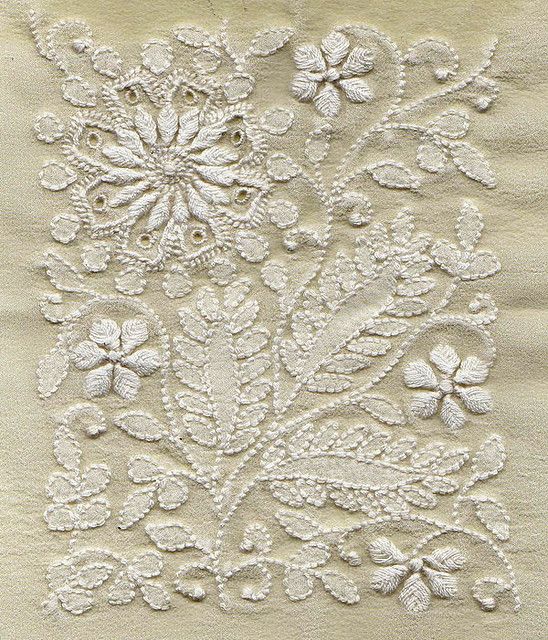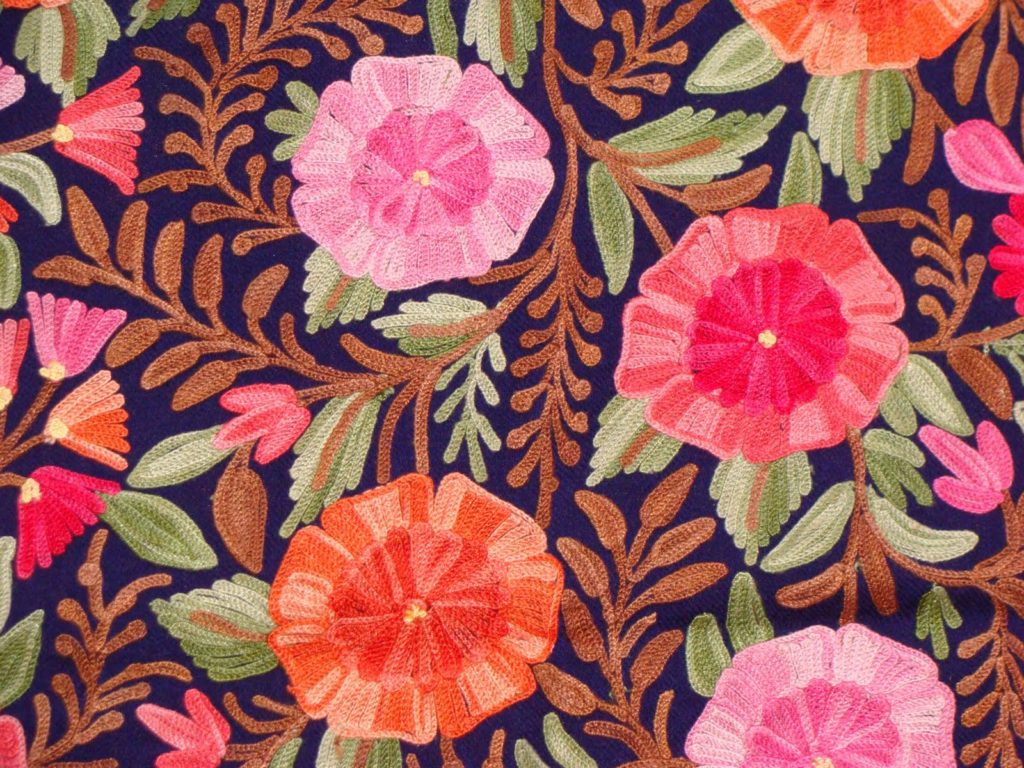BLOG
Types of Embroideries of India
Embroidery is an ancient form of art or handicraft that has been used worldwide for embellishing fabric or other material using needle, yarn or thread. The word embroidery is originated from the French word “broderie”, it signifies embellishment.
While embroidery is practiced in every nook and cranny of the world, its origin roots from china and near east. It evolved in the 3rd century. However, it flourished notably under the rule of Emperor Akbar due to his keen interest in textiles.
India is the rich heritage of textiles since eras with a varying style of traditional embroideries itemizing different aspects of nature and regions. Like Phulkari of Punjab, Chikankari of Uttar Pradesh, Kashida of Kashmir, Zardosi etc. There are various types of Embroideries of India:
1. Phulkari

Phulkari, one of the famous of types of embroideries is the most vibrant traditional folk embroidery of Punjab and has been popular since the 15th century. It was first mentioned in the Punjabi folklore of Heer Ranjha by Waris Shah. The word Phulkari comes from the Sanskrit word which means flower work.
This exquisite motif of embroidery is embellished on shawls, odhnis, Kurtis and chunnis.
The base of phulkari is a dull handspun or khadi cloth with evenly distributed motifs, and elegant panel border embroidered thread by thread in a geometric pattern following an eccentric technique to come up with a curvilinear design. Cities like Jalandhar, Ambala, Amritsar, Ludhiana are famous for Phulkari.
2. Chikankari

Chikankari craftwork is often quoted as Lucknow chikan. It is believed that this art form was introduced by The Mughal Emperor Jahangir’s consort, Noor Jahan and seems to find its roots in Lucknow. This unique subtle shadow work is designed using herringbone stitches on the back of the fabric, resulting in a dainty shadow on the face of the fabric. Traditionally the chikankari motifs were embroidered on muslin cloth, white fabric using white thread. Nowadays it can be seen on myriads of materials and colours. The motifs are inspired from flowers, birds and lace-like motifs. They are popularly used to beautify kurtas, sarees and even home decor items.
3. Kasuti

Kasuti is the style of artistry that has caught the world unaware by its mystic motif. This style of embroidery which literally means handwork with cotton thread has its stems from Karnataka since the 17th century. This form of embroidery is designed to look the same on the front and back of the work, that means darning without using knots from the start till the end of the stitching. The motifs are inspired by flowers, animals, birds, mythological stories, architecture, religion. In ancient times, it was a custom that sarees embroidered with kasuti called as Chandra kali sarees were expected to be a part of the bridal trousseau. It is one of the most beautiful types of embroideries of India.
4. Kashida

Kashida handwork is the beauty etched in the paradise of Jammu and Kashmir. It’s one of the ancient traditional forms of intrinsic art that finds its root in the Mughal reign. The essence of this art form is immersed in its ornate bead and threadwork. The speciality of kashida embroidery is that it is done using a single thread. This intrinsic needlework is mostly taken from nature including flowers, birds, leaves etc. Traditionally kashida embroidery was adorned on shawls, phiran, gabba etc. Nowadays, it is also used to ornament bed covers, lampshades, bags and other accessories. Kashida is one of the most cherished types of embroideries of India
5. Kantha

Kantha an aesthetic handicraft, originated in West Bengal is nearly 500 years old. Traditionally, Kantha embroidery was done on old and discarded garments and other used materials to turn them into something new. Conventionally, women would take 4 to 5 sarees, layer them together and create myriads of running stitches on them and use them as a quilt. The motifs were influenced by natural beauty like lotus, animals, floral, peacock and geometric patterns. This exquisite embroidery was also used in ceremonies and pujas as a symbol of cultural and religious significance.
6. Chamba Rumal

Chamba rumal is associated specifically from Chamba, a hill station in Himachal Pradesh, where it has been practiced for centuries. Chamba rumal is not a usual handkerchief but certainly too rare and precious to wipe your face with. This intricate yet traditional form of pictorial art was beautifully adorned on hand-spun fabric using an untwisted silken thread which finds its roots in Pahari paintings. The motifs on this embroidery mainly revolved around divinities, such as Shiva, Lakshmi, Durga, Vishnu, Ganesh, and Lakshmi. This unconventional form of art was also exchanged by the bride and groom’s families as a sign of goodwill.
7. Zardosi

Zardosi, one of the most beautiful types of embroideries is the magnificent metallic embellishment that came to India from Persia. This historical artwork was patronized by the Nawabs and other princely families. This opulent embellishment was done by using silk threads in real gold and silver wires to decorate satin and velvet fabrics. Along with the threads, other affluent materials such as sequins, beads, precious and semi-precious stones and pearls were also used. Since the art finds its roots from the Mughal origin, the motifs are also inspired by the same ethos. It comprised of complex nature, floral and leaf motifs, contemporary patterns etc. Today, Zardosi is famous in cities like Lucknow, Bhopal, Farrukhabad etc. But the Lucknow Zardosi bears a unique sign of authenticity.
8. Kutch Embroidery

Anciently, it was believed that mochis or shoemakers were taught Kutch embroidery 300 years ago by a Muslim wanderer and that’s why it is also known as Mochibharat. This embroidery of Gujarat is not only famous but also versatile. The stitch used for the motif is used depending on the style such as herringbone stitch, satin stitch, darning stitch etc. This delicate work is done on fabrics such as cotton and silk. Also, a lot of mirrors are adorned on these fabrics with an embroidery stitch. The motifs found commonly are influenced by romantic motifs as well as patterns of human figurines in dancing poses and dancing peacocks too. A lot of motifs are also inspired by Persian and Mughal artwork.
Thank you for reading. You can follow us on Instagram, Facebook, Pinterest.
Written by Ankita Waykar


 WhatsApp us
WhatsApp us
Like!! I blog frequently and I really thank you for your content. The article has truly peaked my interest.